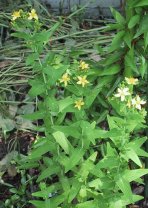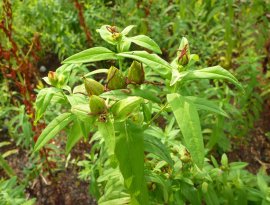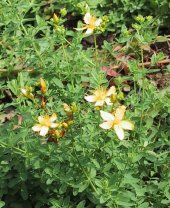Japanese Folk Medicine
-Vol. 4 - Hyperici Erecti Herba- オトギリソウ(弟切草)-

-
 Hypericum erectum Thunb
Hypericum erectum Thunb -
 Hypericum ascyron L.
Hypericum ascyron L. -
 Hypericum perforatum L.
Hypericum perforatum L.
Origin
Hyperici Erecti Herba (弟切草: otogiriso in Japanese) is derived from the entire plant (aerial part) of Hypericum erectum Thunb., which belongs to the Guttiferae family. It is also called shorengyo (小連翹).
H. erectum is a perennial plant that grows on sunny hills, in fields and by roadsides, and is native to Japan (from Hokkaido to Kyushu), the Korean Peninsula, Sakhalin, eastern Siberia, and China. The height is 20 to 60 centimeters, the entirely plant is glazed, levigate, and glabrous. The stem is columnar, slight, hard, and erect. Sometimes 2 to 3 stems crowd together and a small number of stems form a branch. The stem has no petiolus, an opposing leaf arrangement. It is 2 to 6 centimeters long and 7 to 30 millimeters wide. It is lanceolate, has roundish leaves at the extremities, and amplexicaul base leaves. Holding the back side of the leaf up to the light reveals a black oil spot in the mesophyll, which is characteristic of the Hypericum species. The flowering season is July to August, and H. erectum produces several equinoctial panicles from its terminal branches, which are composed of five-petaled yellow flowers 1 centimeter wide. The black spot also exists in the flowers, and there is a calyx at the back of each petal. There is one pistil and multiple stamens. The bottom of the stamen is connected and divided into 3 groups, a characteristic in H. erectum. After the flowering season, a red-brown oval form capsule (length 5 to 11 millimeters) matures. The length of each seed is about 1 millimeter and the seed has a thin reticular pattern.
Because a lot of intraspecific variation occurs, more than 110 kinds of similar species exist in Japan and the classifications are different. The species variants are as follows:
H. erectum Thunb. var. subalpinum Y. Kitamura (sinanoyama-otogiri): The stem is crowded, the leaf is lanceolate oblong or long-oblong in form, and both a black oil spot and a bright oil spot are present in the mesophyll. The sepal is a lanceolate form and a black spot is exists in the sepal and peripheralis. H. erectum Thunb. var. longistylum Y. Kitamura (okuyama-otogiri): Although the stem is crowded, it has only a black oil spot. H. erectum Thunb. var. caespitosum Makino (fuji-otogiri): The stem is noticeably crowded, the height is 30 to 40 centimeters, the leaf is narrow, and the form is lanceolate or narrow- oblong.
Tomoeso (巴草: H. ascyron L.) belongs to the same family, and is a perennial plant that grows in the country in various regions. The stem is erect and H. ascyron produces five-petaled yellow flowers, those characteristics are the same as H. erectum. However, the plant length and the flower size are greater, the former is 60 to 90 centimeters and the latter is 5 centimeters. In addition, although the stem of H. erectum is round, 4 crista are present in the stem of H. ascyron. The entire dried plant is used for swell and as a hemostatic agent. The Japanese name is derived from the five-petaled flower which withers and forms a comma-shaped heraldic appearance.
History
The scientific name Hypericum is derived from the ancient Greek name hypericon and combination of hypo (meaning under) and erice (meaning grass), meaning 'produced between weed'. In addition, the meaning of erectum is erectus, meaning erect.
The Japanese name otogiriso is derived from a legend from the Heian era. A falconer had a secret that the plant healed a wound on a falcon, but his younger brother gave away the secret and was killed. The spattering blood was said to remain on the leaves and flower petals as black spots. It was described in "Wakansansaizue (和漢三才図会)" written in the Edo era in 1713. The plant was grouped as a weed was used as a hemostatic for cuts and to treat sick falcons and dogs in "yamatohonzo (大和本草)" as written by Ekken Kaibara in 1709.
The plant's Chinese name is shorengyo (小連翹) or rengyo (連翹), written Bencao-gangmu (本草綱目). Other names than shorengyo (小連翹) or ryuginu (劉寄奴) were suggested, but those names were not popular as "otogiriso" had a clear meaning and spread in the Edo era.
In China, the name rengyo has not been indicated the Japanese rengyo since ancient times, but the Guttiferae family of H. ascyron and H. erectum. To distinguish the two, H. ascyron is called rengyo (dai-rengyo, meaning big rengyo) and H. erectum is called sho-rengyo (small rengyo) in Chinese. In Japan, the fruit of Forsythia suspensa (Oleaceae family) was wrongly called "rengyo". The character 翹 (gyo) means the shape of a flying pheasant with a spread tail feather, and this indicates the stem of rengyo is erect.
In Japan, some other local names are used for otogiriso, including aogusuri (青薬), ingibana, otogiri, katatou, somekusa, takanokizugusuri (鷹の傷薬), chidomegusa, and bonbana (盆花), etc.
Compounds
The entire plant of H. erectum contains a lot of tannin. In addition, it contains anthraquinone of hypericin, flavonoids of quercitrin and isoquercitrin, etc.
Pharmacological effects and toxicity
The methanol extract of shorengyo has a sialidase inhibiting effect. Also, a water-soluble substance extracted by ethanol increased the action of natural killer cells and macrophages, which are related to the immune system.
Because the black-violet pigment of hypericin absorbs ultraviolet radiation strongly, it is reported that cows, horses, and sheep that eat otogiriso, develop dermatitis and suffer from hair loss when exposed to sunlight. Normal mice in a dark room given otogiriso suddenly went into convulsions and died due to exposed to sunlight; it is also said to the effect of hypericin.
Medicinal effects, dosage, and administration
The essence is Hei (neutral; keeping healthy balance), the taste is bitter, and the plant is atoxic. It has some effects, e.g. activating blood, restraining hemorrhage, adjusting meridian, running milk, healing swelling, and removing pain. Therefore otogiriso is used for hematemesis, epistaxis, metrorrhagia, menstrual disorders, lactation disorders, contused wounds, wound hemorrhages, and small swellings. In "xiandai- shiyong-zhongyao (現代実用中薬)" the medicine is indicated for use as a hemostatic and to treat hematemesis, hemoptysis, epistaxis, and metrorrhagia, etc. In addition, the medicine was used for sword wounds and as a cleaning agent. Moreover, it has also been used as mouthwash for the throat and as fomentation for rheumatism. Fresh liquid is used externally on wounds and contused wounds.
For use as a hemostatic, for menstrual disorders, and analgesia, 3 to 6 g of dried plant is added to 300 mL of water and it is decocted until reduced by half, then drunk 3 times a day.
For adenoiditis and cough, 10 to 20 g of dried plant is added to water and it is decocted until it is reduced by half. Then, the grounds are removed and the mouth is rinsed with the decoction. For scrapes, cuts, swellings, and bruises, the decoction is placed on the injured area. For cuts, contused wounds, and insect bites, it is also good use the extract obtained by kneading fresh leaves. However, it sometimes causes skin irritation due to diathesis, so care must be taken.
The juice of the leaves and the tincture produced by soaking the entire plant with alcohol is good for external injuries to birds, and these are specific medicines for chickens and small birds.
Drinking a decoction produced from 15 g of entire otogiriso plant and 10 g of the fruit of the Japanese umbrella tree (Magnolia obovata), is effective for lumbago and edema. For athletes foot, it is better to make a paste mixture with 1/2 the tincture and 1/2 sesame oil.
For rheumatism, neuralgia, and gout, otogiriso is effective as an analgesic when placed in a bath. Packing a surgery site with a decoction is also beneficial. A liquid produced by soaking otogiriso with distilled spirit is used as a preventive agent against rheumatism and neuralgia.
Others
From August to October, the entire plant is collected during the fruit maturing season, soil is dabbed off, then the plant is bound up after cutting off the root, and it is dried in the sun. The above product is called shorengyo as a crude drug. The drug is preserved in a closed container to protect the contents from extraneous material. It is important to preserve it in a drafty dark place and pay attention to moisture and vermiculation.
The same genus of St. John's wort (H. perforatum L., seiyo-otogiriso) contains hypericin and has been used medicinally for centuries. However, its combined usage with other medicines requires great care because the plant interacts with other medicines even if it has a medicinal effect or not.
The branches and leaves are used for dyeing. The stain is a red-tinged yellow-brown with aluminium mordant, umber brown with iron mordant, and dirty red-brown with copper mordant.
As for liquor with otogiriso: 200 to 300 g of fresh branches and leaves (100 to 300 g of dried material) is soaked in 1.8L of white liquor (alcohol concentration 35%) and preserved in a dark place for 3 to 6 months. Finally, the material is removed and used.
Reference
F. Ikegami, Wakanyaku, 691, 2-3, (2010.12)
